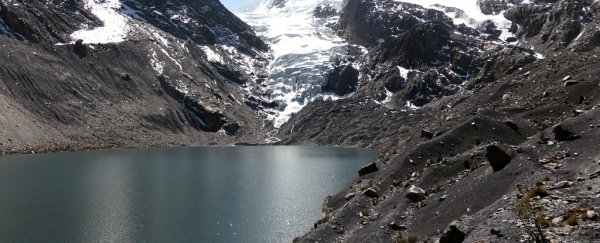Scientists have found that it's not just coastal regions of the world that are at risk from melting ice - a new study shows that shrinking glaciers in Bolivia are set to leave behind lakes that will put nearby villages in danger of flash floods that could wash them away.
The glaciers have shrunk by 43 percent in 28 years, the research shows, and that puts drinking water supplies at risk too, even for the bigger cities such as La Paz and El Alto, which are further away from the mountains.
This is all the result of a 0.7-degree-Celsius (1.26-degree-Fahrenheit) temperature rise over 50 years leading up to 1994.
A team from Manchester Metropolitan University in the UK analysed satellite imagery from the Landsat program, run by the US Geological Survey and NASA. By studying pictures from 1986 to 2014, the scientists were able to chart the shrinking ice cover and the potentially dangerous lakes created as a result.
"Glacier recession is leaving lakes that could burst and wash away villages or infrastructure downstream," said lead researcher, Simon Cook.
"Some lakes are very small and pose little risk. Others are very large, but there's little or no possibility that they would drain catastrophically. Others are both large enough to create a big flood, and sit beneath steep slopes or steep glaciers, and could be dangerous."
The lakes that appear as the ice melts are held in place by bedrock or debris from the receding glacier. Avalanches, rockfalls, or earthquakes can cause these lakes to burst, meaning chaos for towns and villages lower down, as all the water is suddenly discharged.
Officially, these incidents are called glacial lake outburst floods (GLOFs) and the effects can be devastating – especially for the less well-off communities living in rural areas.
The researchers report that the number and size of glacial lakes has risen "significantly" in the Bolivian Andes since 1986, and they've identified 25 lakes that pose a particular threat to both communities and infrastructure if they burst.
Lakes with steep sides are especially dangerous, because it's more likely that ice, snow, or rock will drop into the water and cause an overflow.
Worst case scenario? The scientists estimate that the largest of these 25 lakes could reach a peak discharge of 125,000 cubic metres (4.414 cubic feet) – or 50 Olympic swimming pools – per second.
These disasters are already occurring. Dirk Hoffmann from the Bolivian Mountain Institute, and one of the researchers who worked on the new study, previously reported on a 2009 flood in Bolivia that washed away farm animals, crops, and bridges.
If that wasn't scary enough, the shrinking glaciers also take away an important source of water for the Bolivian people. The 2.3 million inhabitants of La Paz and El Alto receive about 15 percent of their water supply from the mountain glaciers – a percentage that almost doubles during the dry season.
The lakes and rivers supplied by the glaciers are also under threat, and the team estimates just a tenth of the glacier cover from 1986 could be left by the end of the century. The scientists are calling for more research to investigate the scale of the problem and potential solutions.
The more we know, the better we can adapt, and for now, it's important just to raise awareness of the issue. "It's a chance to put the entire jigsaw puzzle together," Cook told Sarah Emerson at Motherboard.
The glacier report has been published in The Cryosphere.
